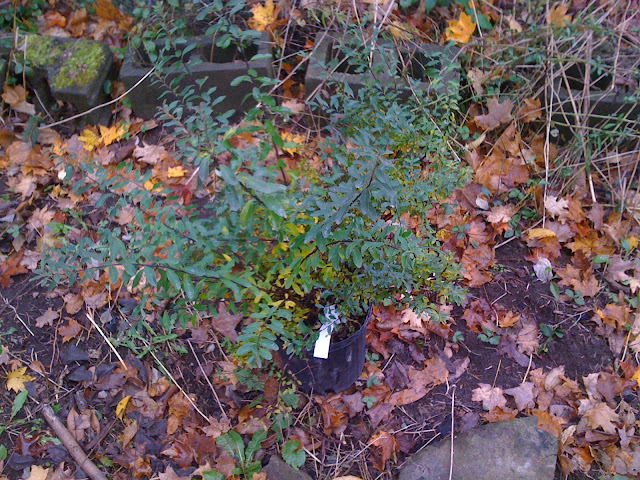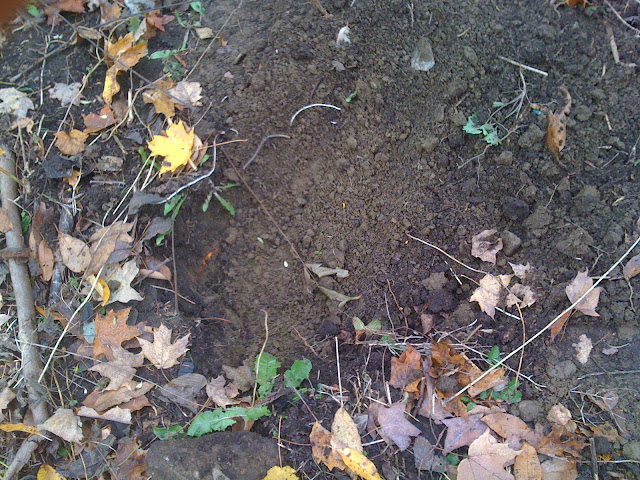On Saturday morning, I took a trip to the local nursery, about 10 minutes away. I've probably been to a nursery at some point in my life, but this is most likely the first time I went to a nursery and actually wanted to be there. Now, when I go shopping, it's typically an in-and-out affair...I know what I'm there to buy, and the sooner I'm out of the store the better. My mission in my nursery trip, though, was to take my time, browse through the plants to see the kind of selection they have, and come away with a shrub to plant along the fringe of my garden. The nursery closes for the season at the end of October, and I wanted to have something new for the yard before then.
I browsed all of the plants, and I was overwhelmed by the selection. This plant does well in the shade; that one is more deer-resistant. Plants with flowers of different colors; plants that flower in different seasons. The one thing I learned from looking at all of the plants was that if there's a popular garden plant or wildflower that I want to plant in my garden or yard, this place will probably have it. Fortunately for me, I have all winter to research what I want to plant in and out of my garden. After I had surveyed all of the plants, I zeroed in on the shrubs, and in particular the deer-resistant ones. There's a family of three deer (doe and two fawns) that resides in my neighborhood, and I see them around all the time. I don't mind them, but at the same time, I don't want them eating my first purchase.
I had a shrub picked out, but I figured I'd be better off asking an expert for advice, so I got the attention of one of the nice young women working for the nursery. She recommended a different shrub, the one that she said was the most deer-resistant. It can also survive in a mostly shady environment, which is what a shrub needs if it's going to survive along the fringe of my garden. Native to Japan, its scientific name is Spiraea nipponica (nipponica means "of Japan"), and it's more commonly known as Spiraea "Snowmound" for the white flowers that bloom in late spring to early summer. And I now know more about Spiraea nipponica than I know about any other shrub in the world.
With my Spiraea (hereby dubbed "Shrub") in hand, one that was especially picked out for me by the nursery worker (she said that she looks for a plant with even growth all the way around), I proceeded to the office to check out. I noticed a book on display, "Native Plants for Native Birds", written specifically for the Ithaca area. I'd been planning a blog post for this week on this very topic, so I couldn't resist buying the book as well. It will be great for my garden research this winter.
When I got Shrub back home, I took him around back, plopped him on the ground, and took a picture so the world could meet Shrub:
Then, I carefully extracted Shrub from his plastic pot, loosened the soil around his roots, especially near the bottom, and carefully put him in the hole:
And finally, I filled in the dirt so that Shrub was securely in place:
Now, I probably did half a dozen things wrong. There's one thing in particular that I know I did wrong: I put him too close to one of the other shrubs in the fringe of the garden, but I realized this too late. I'll have to move him next weekend. In the meantime, I'll give him plenty of water and hope that the deer don't eat him.
So that's my first adventure with buying and planting something for the garden. My parents are coming for a visit next weekend, and I'll get plenty of advice from them, since they actually know what they are doing. In the meantime, I'll do my best to keep Shrub happy and healthy.







Well, if you took it easy a few days ago watching the squirrel bury a nut, it looks like you've made up for lost time now...a lot of work! Hope your shrub does well.
ReplyDeleteYour shrub will be so pretty next spring when it's covered in blooms! I hope it loves its new home.
ReplyDelete